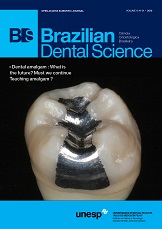Dental caries on distal surface of mandibular second molars
DOI:
https://doi.org/10.14295/bds.2015.v18i1.1063Abstract
Objective: The aim of the study was to evaluate the frequency of distal caries in the second molar influenced by the angulation of the third molar adjacent on panoramic radiographs in a clinical dental radiology. Material and Methods: A descriptive and quantitative study that examined 750 panoramic radiographs, of this total, 120 were in accordance with the inclusion criteria of the study was conducted. Results: 157 seconds and third molars analyzed the prevalence of caries in the distal of the second molar was 25.5%. The most prevalent angle position of the third molar was 57.3% with the vertical, but the position with the highest percentage of decayed molar second distal mesioangular was 50% of the cases. The elements listed, males obtained 40% of second molar distal caries versus 17% for females. People aged 35 or older had the highest incidence with 50% distal caries while other bands obtained 16.21% in the group 18-24 years, and 23.52% in 25-34 years. Conclusion: It was possible to establish a sliding scale on the indication for prophylactic removal of mandibular third molar according to the angulation of Winter: horizontal, mesioangular, vertical and distoangular. One can also see a greater relevance to the indication of prophylactic removal of male individuals aged over 35 years.
Downloads
Downloads
Additional Files
Published
How to Cite
Issue
Section
License
Brazilian Dental Science uses the Creative Commons (CC-BY 4.0) license, thus preserving the integrity of articles in an open access environment. The journal allows the author to retain publishing rights without restrictions.
=================




























